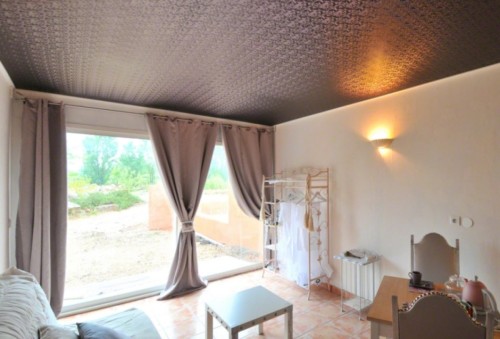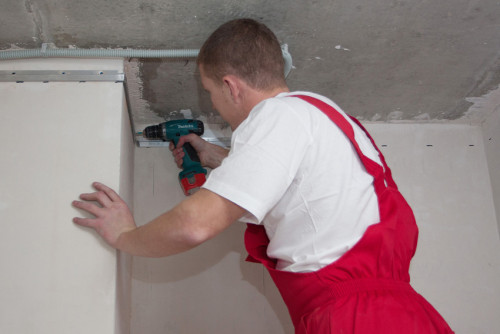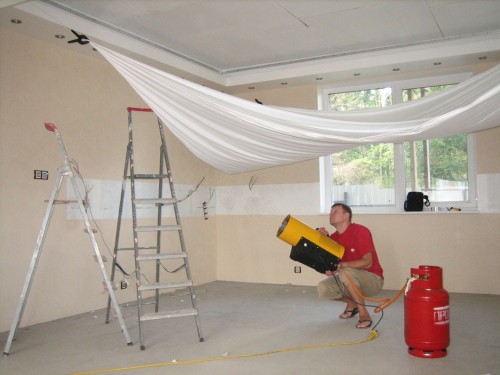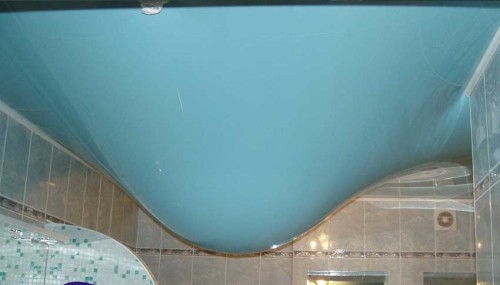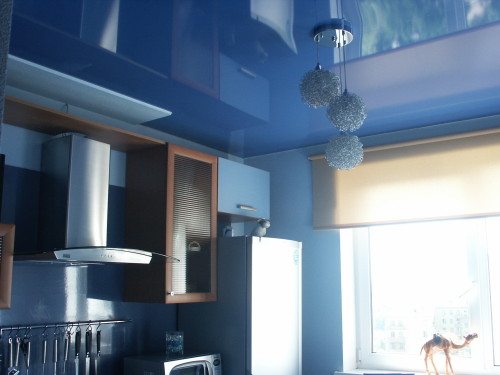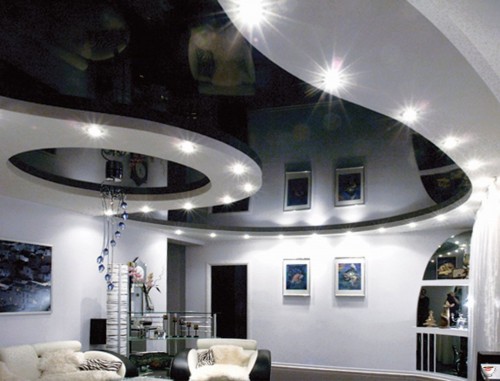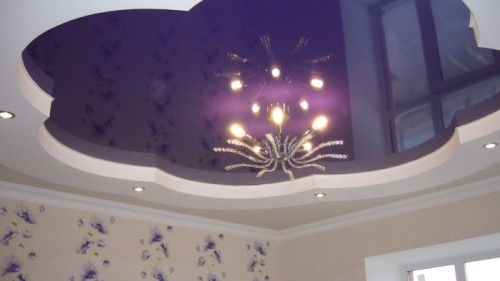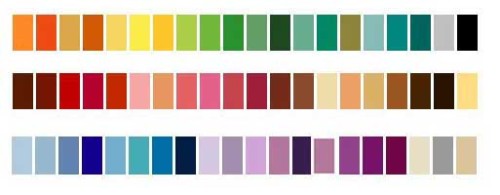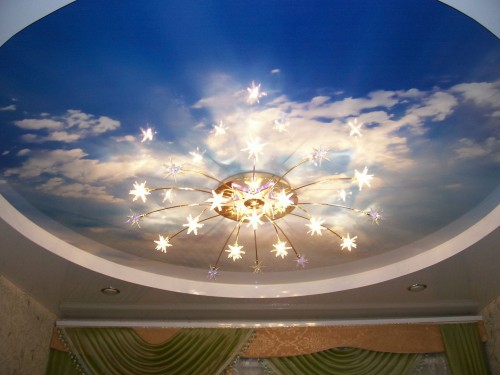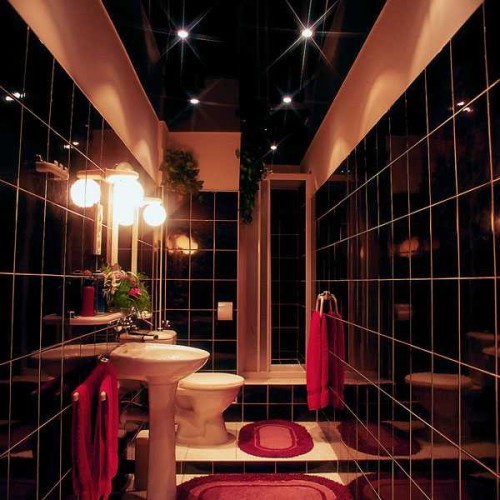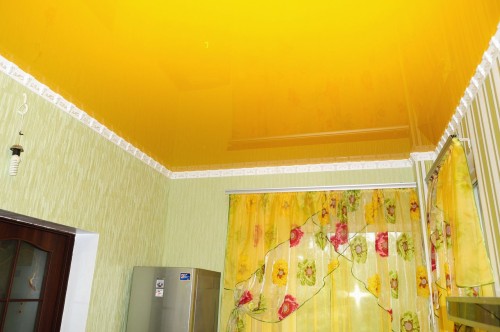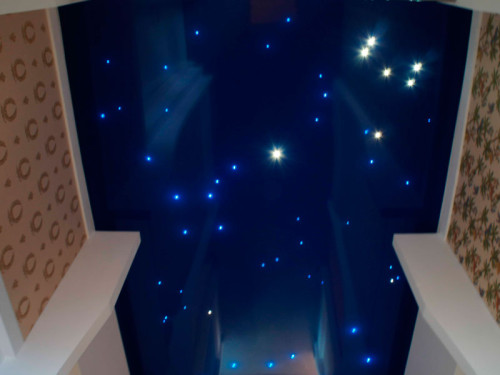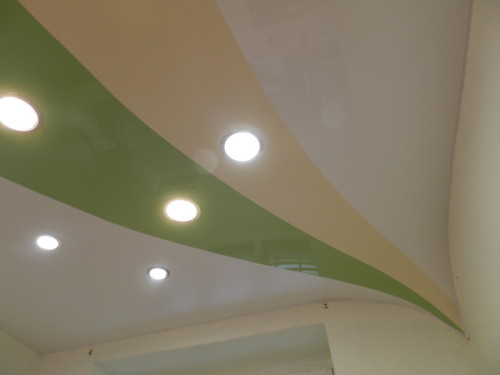
Glossy stretch ceilings in the interior of the apartment Ceilings
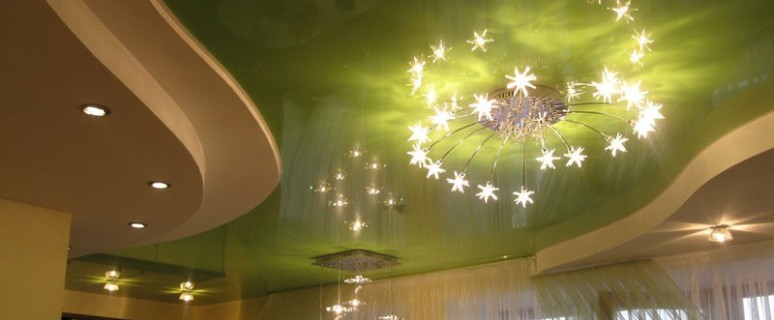
Modern technologies allow you to quickly and effectively change the interior in the apartment. Such technologies include stretch ceilings. Unlike traditional plaster and plasterboard systems, their installation takes up little time. At the same time, a perfectly smooth surface is formed. What are the stretch ceilings, about the principles of their installation and about the care of them and go on speech.
Content
Types of stretch ceilings
The stretch ceilings in three signs are distinguished:
- by manufacturing material;
- on the surface texture;
- in the width of the canvas.
Fabric stretch ceilings
This canvas is a synthetic cloth with vinyl impregnation. Such material is characterized by special strength and resistance to mechanical effects. In addition, the synthetic canvas is characterized by the following qualities:
- components from which fabric are made do not distinguish substances harmful to humans;
- the surface texture is well combined with other elements of the interior;
- micropores of the material allow you to "breathe" the basis of the ceiling, which prevents the formation of condensate and, as a result, mold;
- roll width (up to 5 m) allows in most cases the installation of seamless coatings;
- it is not afraid of low temperatures, which allows the use of material for finishing unheated premises (for example, balconies and loggias);
- installation is performed without using a heat gun, which makes it available for self-execution.
Fabric glossy stretch ceiling is recommended for the interior device in the children's room. Children, playing, will not damage the canvas, and if necessary, it can be easily put in order.
There are also disadvantages of tissue ceilings.
- Micropores of the material are quickly clogged with dust, which requires frequent care of the surface of the ceiling.
- Absorbs odors, in connection with which the use of fabric ceilings for decoration of the kitchen is not recommended.
- Reparatively high cost.
Film ceilings
The glossy stretch ceiling (see the photo below) is a thin (about 0.22 mm) film made on the basis of polyvinyl chloride (PVC). It produces in rolls width from one and a half to two meters.
The solid canvas are made by order: separate strips are welded using high-frequency current. Mounting consists of several stages.
- At the selected distance from the main ceiling, the horizontal line is noted throughout the perimeter of the room. An indent depends on the sizes of point embedded lamps, if such provided (plus 1.5-2.0 cm).
- To the wall of the marked line with the help of a dowel-nailing of the aluminum profile.
- With the help of special wedges or the harpoon method, the polychlorial can be installed.
- Heat the thermal flush film and fill it finally in the aluminum profile. Cooling, the canvas stretches.
- The plinth is covered with a slit on the wall of the wall and the canvas.
Important: During installation and operation, it should be carefully treated with a tensioning film ceiling from polychlorvinyl. Even a small scratch can cause the loss of the appearance of the canvas or its complete unsuitability.
Benefits of the glossy ceiling from PVC
- The glossy ceiling from the PVC film can prevent flooding of an apartment in the event of a water supply accident from neighbors from the top floor.
- The glossy texture visually increases the space, which is especially important for premises with low ceiling.
- Unlike fabric, do not absorb smells of glossy stretch ceilings. High-tech kitchen with a PVC film ceiling is presented in the photo.
- PVC film does not fade, does not lose its appearance over time.
- Glossy stretch ceilings in the bathroom are not afraid of damp: condensate does not penetrate the film, which means that the mold is not formed.
- Under the tension film you can hide wiring, ventilation system or other engineering communications.
- With the help of embedded point lights and LED decorative illumination mounted around the perimeter of the room, an original interior is created.
- The glossy canvas can be used as inserts in multi-level structures.
Important! In the case of flooding neighbors before dragging water, it is necessary to de-energize the wiring in the apartment.
Colors of the glossy stretch ceiling: recommendations for choosing
PVC canvases are produced in various colors, with many shades. You can choose a tone film with other elements of the interior finish.
By ordering the cloth for the ceiling in the apartment, you should be guided by the following principles when choosing a material.
- Stretch glossy white ceiling will be the best solution for small room. You can visually increase living space by installing a canvas of a blue color or another cold shade: a feeling of heavenly infinity occurs. The effect can be enhanced by the image of the clouds.
- Black glossy stretch ceiling, on the contrary, used for finishing large rooms. Designers also recommend other dark tones: brown, dark blue or dark green.
- Create a cozy, warm interior can be used with bright shades. PVC film of yellow or orange color pleases the eye and improves the mood.
- The classic interior involves the installation of the cloth lighter compared to the walls. Support for basic color is also allowed.
- Stretch ceilings with photo printing look original. It can be a picture of the starry sky, the sea or imitation of some natural materials.
However, care should be taken to the choice of the picture: it does not have too much to prevail over the rest of the interior objects and be tedious.
- Fabrics of different colors can be sewn together, which can be used to create unusual interior cafe, children's play room, or dance hall or sports facilities.
How to care for stretch glossy ceilings
In order for the ceiling material for a long time and had a proper look, it is necessary to care for it. The treatment of antistatic substances allows you to wash the PVC film not too often. But the monthly stretch ceilings should be cleaned with a vacuum cleaner, and once a year washed with a damp soft cloth moistened in soap solution.
How to wash stretch glossy ceilings so as not to damage them? Experts recommend the following.
- Inspect the cloth: the sweat gloss indicates the need to wash the stretch ceiling.
- Ceiling cleaning with a vacuum cleaner is performed using a wide and smooth nozzle. The suction power is selected medium. You can not use brushes to work: rigid porks can damage the cloth.
- The vacuum cleaner can be used at maximum power, but the nozzle should not touch the surface of the glossy film.
- Washing the ceiling manually is carried out using soft napkins from microfiber. You can use a sponge that does not have abrasive inclusions.
- As a detergent, any household chemicals that do not contain abrasives, acetone, kerosene, concentrated acids and alkalis can be used. But to avoid problems, before applying the detergent, it is necessary to try its action on the film on the lowest segment of the ceiling.
- There are special alcohol-containing facilities for the care of the stretch ceiling. But they cannot be used for films with photo printing.
- If necessary, you can use the mop: PVC strength quality will not allow the material to be damaged. However, there is no excessive effort to apply.
- A good detergent for washing the stretch ceiling is a soap solution with the addition of 10% of the ammonic alcohol. Replace the ammonia can be ordinary vodka. The detergent solution should be warm (+ 30 ... 40 ° C).
- Apply the detergent should be directly on the ceiling film, and not on a napkin or sponge. Wipe the ceiling with light circular movements.
- After moisturizing the glossy film, it is necessary to thoroughly wipe dry with a rag from the microfiber or a flannel napkin, otherwise traces of divorces will remain on its surface.
Important! During the wave of the ceiling, it is necessary to remove the wristwatches, bracelets and rings to avoid damage to the thin film. If the scratch was formed - it is stuck with scotch and cause specialists to repair.
In conclusion of the story about how to choose, assemble and put in order a tension glossy ceiling - video, where the dispersion process is represented with the explanations of the specialist.




